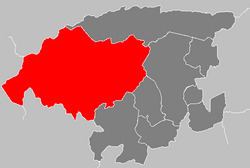Country Venezuela Time zone VST (UTC-4:30) | Website Official website Area code 0252 | |
 | ||
The Torres Municipality is one of the nine municipalities (municipios) that makes up the Venezuelan state of Lara and, according to a 2007 population estimate by the National Institute of Statistics of Venezuela, the municipality has a population of 188,188. The town of Carora is the shire town of the Torres Municipality.
Contents
- Map of Torres Lara Venezuela
- History
- Economy
- Demographics
- Government
- Education
- Lisandro Alvarado Center West University
- Antonio Jos de Sucre National Experimental Polytechnic University
- Other universities
- Culture
- References
Map of Torres, Lara, Venezuela
History
The town of Carora was founded in two occasions. The first time, in 1569 by Juan de Tejo, but it was evacuated, because the attacks of the local natives, was founded again in 1572 by Juan de Salmanca. Carora has one of the most beautiful colonial zones, and better conserved in Venezuela. This is appraised in the streets and the colonial line maintained, observed in each of the houses of this part of Carora. One of the very interesting characteristics of this colonial zone, is that most of the houses, are being occupied by descendants of the original owners. The main commercial activity of the region is the cattle ranch, specifically to the milk processing. The Cathedral of San Juan Bautista (Saint John the Baptist) was constructed at the beginning of 1600, with a very simple and clean facade. In the inner part it is decorated with wood pillars and forged iron lights, in addition to a gold, wood made altar. Between the sites of interest in Carora, they are: The José Zubillaga Perera Library, the birthplace of the Venezuelan hero Juan Jacinto Lara, well-known like Lara House, the Fine arts Center. Also the Chapel of El Calvario, an example of the colonial baroque architecture. Also in this historic zone, there is a well-known place of the town: the Torres Club. Founded in 1898, has like seat a good shape colonial house. It has a restaurant and a "Healthcare center", that is only for members, usually can be visited by the tourists.
Economy
Demographics
The Torres Municipality, according to a 2007 population estimate by the National Institute of Statistics of Venezuela, has a population of 188,188 (up from 167,869 in 2000). This amounts to 10.5% of the state's population. The municipality's population density is 27.06 inhabitants per square kilometre (70.1/sq mi).
Government
The mayor of the Torres Municipality is Julio Rafael Chávez Meléndez, elected on October 31, 2004 with 36% of the vote. He replaced Javier Oropeza shortly after the elections. The municipality is divided into 17 parishes; Trinidad Samuel, Antonio Díaz, Camacaro, Castañeda, Cecilio Zubillaga, Chiquinquirá, El Blanco, Espinoza de los Monteros, Lara, Las Mercedes, Manuel Morillo, Montaña Verde, Montes de Oca, Torres, Heriberto Arroyo, Reyes Vargas, and Altagracia.
Education
Lisandro Alvarado Center-West University
(Universidad Centroccidental Lisandro Alvarado) or UCLA, is a public institution with seat in Barquisimeto, created on September 22, 1962, under the government of Romulo Betancourt, with the name of Experimental Center of Superior Studies, it begins with four schools: medicine, agronomy, veterinary and administration. In 1967, the name is changed to Center-West University, continuing the educational and administrative activities of the Experimental Center of Superior Studies. On April 2, 1979, Venezuelan government rename the organization like Lisandro Alvarado Center-West University.
Antonio José de Sucre National Experimental Polytechnic University
(Universidad Nacional Experimental Politécnica Antonio José de Sucre) or UNEXPO, is a public institution, with nucleus in Carora. The history of the University begins with the proposal from the UNESCO to the Venezuelan government, to install a Technological Institute in the country, offering technical attendance, and resources. Three cities were interested in the offer, Caracas, Valencia and Barquisimeto, being chosen the last one like principal seat, thanks to the campaign made by the Society of Friends of Barquisimeto, with the support of the Lara state government and the mass media. On September 22, 1962, is founded the Superior Polytechnic Institute, with main seat in Barquisimeto, and on February 20, 1979, the Antonio José de Sucre National Experimental Polytechnic University is created, the institutes of Barquisimeto, Caracas and Puerto Ordaz, happened to integrate this university of high hierarchy in the national technology. By a lamentable decision of the national government, through Decree Number 68, on April 19, 1979, it countermanded the creation of the University. Twelve years later, on February 14, 1991, the Venezuelan court, countermanded Decree Number 68, and consequently restituted the University.
Other universities
Culture
Carora has been the birthplace of very important people in knowledge different areas. Guitarist players Alirio Diaz and Rodrigo Riera; historians Gillermo Moron, Ismael Silva Montañes, Ambrosio Perera; lawyers Ambrosio Oropeza, Juan Oropeza, Antonio Oropeza; health science Dr. Pastor Oropeza; and lawyer and one of the writers of the 1961 Venezuelan Constitution Jose "Cheito" Herrera Oropeza; were born in this small Venezuelan city. The Oropeza family, which hails from Carora, is particularly wealthy and conspicuous.
